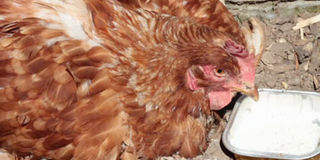How you can manage bird flu

Jeremy Musila a horticulture farmer tends for his french beans. Courtesy photo
What you need to know:
- Highly pathogenicity avian influenza is extremely contagious and kills approximately 90 per cent of all birds (chickens) that catch the disease, writes Christine Katende.
One of the major problems poultry farmers face is bird flu (Avian Influenza or HPAI H5).
This is a viral disease that affects wild birds, captive wild birds and domestic poultry, including backyard chickens, according to Dr Samuel Nsubuga, a veterinary doctor affiliated to Smart Agribusiness Forum Africa. Bird flu if not attended to immediately, can sweep the whole farm.
However, there are two forms of avian influenza, that is low pathogenicity (LPAI) and high pathogenicity (HPAI).
Of the two, the most common one is low pathogenicity avian influenza. Nsubuga says it is mostly harmless and the infected chicken will react with general flu and cold-like symptoms. Highly pathogenicity avian influenza is extremely contagious and kills approximately 90 per cent of all birds (chickens) that catch the disease.
How it spreads
According to the veterinary doctor, birds contract the virus via contact with nasal secretions or faeces from an infected bird.
The virus can also spread through; poor biosecurity ventilation in the poultry house, lack of knowledge about bird management, free entrance to outside wild birds, movement of manure in which it can stay for up to 100 days, clothing and shoes of people who visit the bird houses, movement of infected flock into non-infected flock and sharing of equipment and shelter between infected and non-infected birds.
Symptoms
There are different ways in which bird flu manifests in a poultry house, according to Nsubuga. It however calls for farmers to always be keen, so as to take immediate action. The symptoms may include the following among others, respiratory symptoms, behavioural changes, low egg production, physical signs, gastrointestinal symptoms.
Respiratory symptoms
Influenza is a respiratory virus, so birds and poultry with bird flu may exhibit respiratory symptoms such as coughing and wheezing.
There may also be nasal discharge, in some cases tinged with blood, according to the veteterinary doctor.
Behavioural changes
Nsubuga says birds with avian influenza often behave differently than before they get infected.
For example, they may seem depressed or be inactive. They tend to eat and drink less than normally.
The expert adds that the birds may also suddenly seem uncoordinated and become unable to stand or walk normally.
Treatment
Although the virus is very contagious, Nsubuga says that it can be treated as long as the farmer identifies the situation quickly.
The treatment for the virus include antiviral medication which often requires intensive supportive care. However, he advises that the treatment be carried out by a professional veterinary personnel.
“Farmers should avoid trials and testing of treatment doses they are not sure of, as these can result into killing of birds or even misuse of drugs and vaccines,” he cautions.
Dr Nsubuga also gives supplements inform of natural herbs a farmer can give birds as treatment for the virus. Aloevera: This is locally known as kigajji. With this, he says that cut pieces of fresh aloevera leaves and put them in drinking water and let the birds drink it.
Red pepper: It is known as pilipili or kamulali. Crush these and infuse them into drinking water. Make the birds drink this concoction as this targets their breath problems and respiratory symptoms.
However, some of the control measures which can be used to avoid the cases of bird flu include; vaccinating uninfected birds. This renders the virus harmless thus avoiding cases in vaccinated birds.
Vaccination also improves immunity and body defence towards influenza virus.
In this case, a farmer has to vaccinate the birds before cases break out.
Separate the infected birds from the healthy ones to avoid contact. These should be put far away from the poultry house which contain health birds.
Egg production
If they have stared laying eggs the time they get infected, the infected egg-laying birds often produce fewer eggs than before.
In addition, the egg shells also tend to be soft or with a ram shackled shape (misshaped).
Physical signs
Birds start ruffling of the feathers, the colour of the combs and waddles on the birds turn to bluish-purple. “Swelling is visible in the combs, waddles, hocks, eyelids and the head,” Nsubuga says.
Gastrointestinal symptoms
These appear inside or within the stomach, in the internal parts of the bird. Diarrhoea may develop in some birds with avian influenza.
The other symptoms that may indicate that your poultry farm has been attacked may include; sudden death without any signs, lack of coordination, lack of energy and appetite, nasal discharge, decreased egg production, coughing, sneezing, bird dozing, poor breathing, low appetite and general weak appearance.




